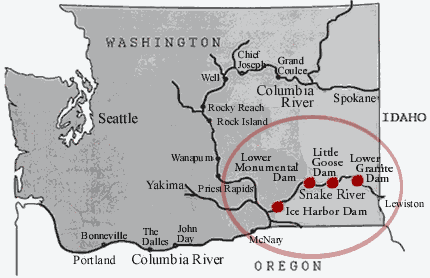forum
library
tutorial
contact

Snake River Dams Plan Needed for Idaho Salmon,
Fiscal Responsibility and Social Justice
by Pam Conley
Idaho Statesman, March 15, 2021
|
the film forum library tutorial contact |

|
Snake River Dams Plan Needed for Idaho Salmon,
by Pam Conley
|
 Two state representatives recently questioned Rep. Mike Simpson's “Columbia Basin Fund” plan, which includes breaching the four lower Snake River dams to save Idaho's salmon.
Two state representatives recently questioned Rep. Mike Simpson's “Columbia Basin Fund” plan, which includes breaching the four lower Snake River dams to save Idaho's salmon.
We welcome the opportunity to address these concerns. First, we applaud Rep. Simpson's bold plan, highlighting the need to breach the dams, while investing in the future. The plan will recover abundant salmon, modernize energy and transportation infrastructure and create thousands of jobs.
HOW WILL LOST POWER BE REPLACED IF THE FOUR DAMS ARE REMOVED?
Currently the dams' production is not needed, nor will it be in the future. Mainly, that's because most power is generated during spring run-off, when demand is lowest. Bonneville Power Administration says energy surpluses will continue.
Energy from wind and solar is rapidly expanding. Electric bills will drop with more wind and solar. Simpson's plan moves us faster to more affordable, efficient renewable energy infrastructure.
WHY TARGET THE LOWER SNAKE DAMS?
The Lower Snake River dams' ecological and economic costs far outweigh their benefits. Upstream of the dams lies 5,500 miles of pristine, high-elevation spawning habitat. With the dams breached, Idaho fish will need to pass only four Columbia dams.
Deflecting responsibility for extinction of Snake River fisheries to other dams is unwarranted. Other dams like Hells Canyon block less valuable habitat.
ARE THE DAMS EVEN REALLY THE PROBLEM?
Established scientific evidence shows these four dams are a major problem for salmon. Snake River wild fish survival rates are not reaching the established 2% replacement goal.
For each additional dam, fish survival declines. Fish from the John Day River survive better with only three dams to pass. The Snake River salmon are heading toward extinction unless the dams are breached.
WHAT ABOUT LAST YEAR'S COLUMBIA RIVER SYSTEM OPERATIONS ENVIRONMENTAL IMPACT STATEMENT REPORT?
This latest report likely won't withstand court review, with the court having invalidated five prior studies keeping the dams. This environmental impact statement found dam-breaching the best option to recover fish, but the agencies refused to follow it.
Simpson's plan proposes halting litigation, providing certainty for decades. While some moratorium provisions create concerns, these are resolvable.
WHAT ABOUT BARGE AND OTHER RIVER TRAFFIC?
Lower Snake River barge traffic and volume has declined drastically in the last two decades. Barging relies on taxpayer subsidies. Huge taxpayer costs of Lower Snake River navigation have risen, and will continue to rise.
Spending from cruise ship travel pales compared to revenues from better fishing and recreation.
The Columbia River navigation system handles more traffic and freight. Shippers have other ways besides barges on the lower Snake to move products. Simpson's plan will enhance regional transportation options.
CAN WE EVEN AFFORD THIS PLAN AND WILL IT WORK?
Yes and yes. We can't afford not to breach the Lower Snake River dams. Failed fish mitigation has already cost $17 billion; spending billions more is fiscally irresponsible.
The weight of scientific opinion supports breaching the dams as the only way to meaningfully recover wild Idaho fish, especially with climate change.
Breaching the earthen berms of the dams is straightforward. Simpson's $33.5 billion fund allots $1.4 billion for direct breaching costs. The remaining $32 billion is for other projects.
Fundamentally, we agree it is morally wrong to let wild fish go extinct. Tribes, including Nez Perce and Shoshone-Bannock, support Simpson's plan. Social justice demands that we honor tribal rights previously disregarded.
Future generations will suffer the ecological consequences if salmon go extinct. Rep. Simpson's proposal provides a blueprint for how to act now to save salmon and revitalize the Northwest for the future.
learn more on topics covered in the film
see the video
read the script
learn the songs
discussion forum
